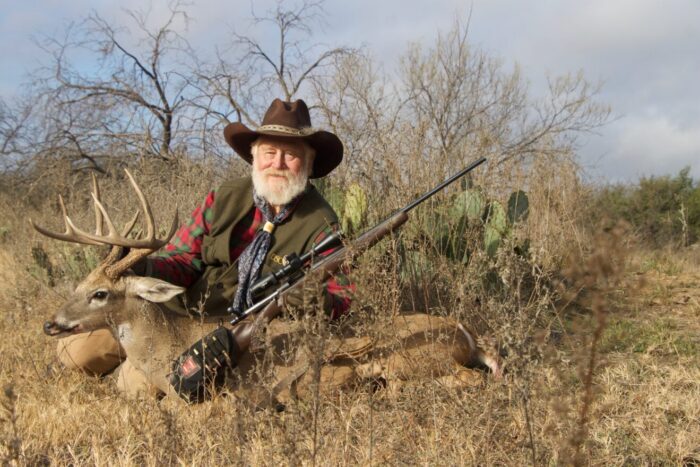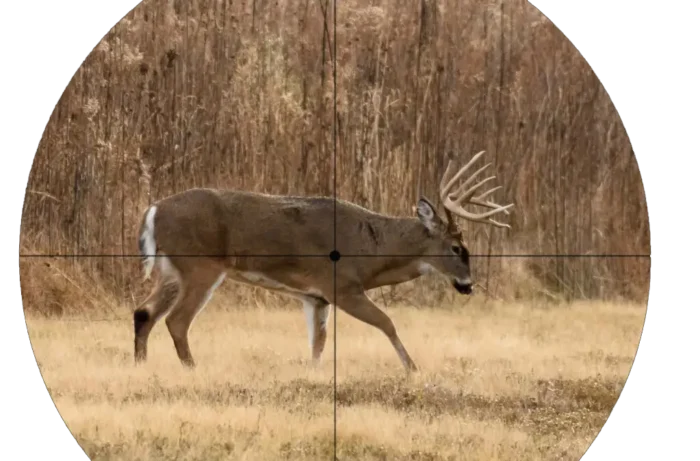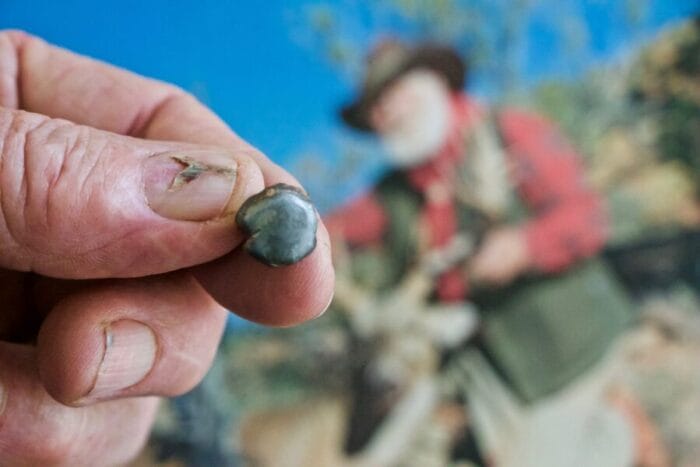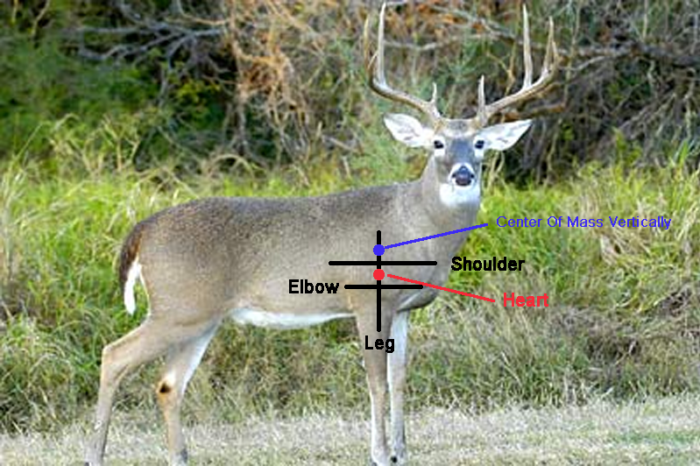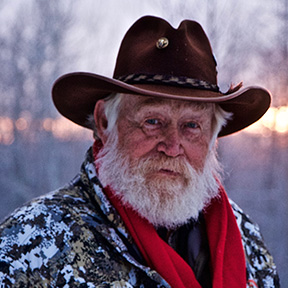Shot Placement on Whitetails
I whispered, “Soon as you get a clear shot, shoot the buck behind the shoulder.” My hunter nodded. Having watched him shoot at the range a couple of days earlier, I knew he handled his .309 JDJ Contender safely and could take the “X” out of the 10-ring at 100 yards with every shot. However, there’s a lot of difference between shooting paper and a real animal.
As the buck cleared the brush, I whispered, “Take him!” At the shot the buck faltered momentarily then had seen was gone. I was convinced the bullet strike the deer well behind the shoulder, quite possibly beyond the thoracic area.
“Did I get him?” queried my hunter long before the echo of the shot subsided. “Where were you holding when you squeezed the trigger?” I asked.
“Right where you said to-behind the shoulder about halfway back,” replied my hunter. At that point I realized he had shot right where I had told him to. Unfortunately, I had failed to tell him exactly where behind the shoulder. After all, probably 70 percent of a deer’s body is behind the shoulder.
I told my hunter I felt assured we would find the deer, but it would be best if we stayed put at least a couple of minutes to catch our breath and give the deer an opportunity to give up the ghost. All the while I was trying to tell myself it would work out, but I also knew there was a good possibility we had a gut-shot buck on our hands that would require many long hours of searching and possibly even bringing in a tracking dog.
A couple of minutes later I decided it would be best if we at least assessed the situation by looking for blood. Sure enough I found blood behind where the deer had been standing, indicating a pass through shot. Knowing the deer was indeed shot, I picked up his trail in the soft dirt. There was dark red blood on the ground. Where the deer ran through some tall grass I found more blood up fairly high, which is as I had suspected. Without saying much, I checked the .45 Colt Ruger Blackhawk carried on my belt to be sure it indeed was loaded. We picked up the track and much to my surprise, within less than 30 yards of where the deer had been shot, there lay the old buck as dead as if he had been shot through the heart.
After hearty congratulations and photos, I gutted the deer, anxious to see what type of wound that far back (well behind the diaphragm in the upper paunch area) had caused the deer to die as quickly as it did. I suspected a liver shot. That’s exactly what it was. The liver was destroyed.
While we had the deer down, I spoke with the excited hunter about where to shoot his next deer, pointing immediately behind the shoulder anywhere from halfway down from the top the shoulder area to about two- thirds of the way up from the brisket, pointing out how the heart and lungs laid in the body cavity and how normally anything as far back as his shot would not cause immediate death. We, you see, had been lucky! There- after anytime I told someone to shoot a deer behind the shoulder, I was explicit in my instructions. Proper shot placement is the responsibility of every hunter! We owe the whitetails we hunt at least that. Our aim should be true so we can take the animal as quickly and humanely as possible.
CHOOSE BULLETS AND LOADS TO MATCH GAME SIZE
Bullets kill by hydrostatic shock, vital tissue damage, and blood loss caused by hemorrhaging through the wound channel. That is why when hunting whitetails it is also our responsibility to use a bullet with controlled expansion that does not fragment upon impact on the exterior of the body but expands as it enters the deer’s body, creating a wound channel and destroying vital organs.
Use a bullet designed for deer and deer-sized animals. In so saying I realize the size of whitetails varies considerably across North America. My smallest bodied whitetail buck is a four-year old of the Carmensis sub- species from the Chinati mountains in far West Texas that field-dressed a meager 45 pounds, which is typical of their tribe. My largest whitetail of the northern subspecies field-dressed in excess of 300 pounds. Choose your bullets and loads accordingly.
Before getting into telling, you where I think you should shoot a whitetail buck, let me give you a bit of my background. What follows is to merely let you know that I have taken “a few” whitetails during my time and have had at least a little experience. I believe experience to be a good teacher. I have always paid attention to those with more experience than me. You see, I’ve been hunting whitetails for well over 40 years. About 30 of those years, I have been a wildlife biologist specializing in whitetails, including working several years as a research biologist in the field of wildlife diseases. As a biologist I have “collected” more whitetails than most hunters get to see in several lifetimes. That’s no brag-it is simply a fact. I have also shot a fair share as a dedicated hunter, having hunted whitetails throughout North America.
I have shot whitetails with everything from .17- to .58-caliber guns and from every conceivable angle, often while conducting a wide variety of research. With every deer I have shot, as a biologist or as a hunter, I have carefully evaluated the effects of the caliber, bullet, and load used and performed an extensive necropsy to determine the bullet’s effect on the deer and the shot placement. I have also outfitted and guided a fair number of whitetail hunters.
Thus, my opinions on where to shoot deer are based on experience, some good and some not so good.
FORGET THE NECK - GO FOR THE SHOULDER
One shot I strongly disapprove of and will not allow anyone hunting with me to attempt is a neck shot. The only way I’ll take a neck shot is if the animal is already wounded. The vital neck shot is to either destroy the spinal cord or one of two major blood vessels. The neck shot at best is a low- percentage shot when it comes to killing an animal. I’ve seen numerous neck-shot deer go down as if pole- axed. They stay down momentarily then get up and run off, leaving virtually no blood trail to follow, only to die much, much later due to infection. In my opinion, neck shots are no more to be attempted as shooting a deer in the gut (paunch, lower intestine area). Avoid neck shots!
Over the years I have hunted a lot of different places for whitetails, and on each hunt, I have asked the guide or outfitter where he or she suggests their clients shoot a deer. The replies are just about evenly split between through the shoulder and right behind the shoulder on a broadside shot. I try to oblige by following their wishes, whichever they suggest. Left to my own decision, however, if the angle allows, I will almost always try to break the shoulders. If the deer is quartering towards me, I’ll try to break the on-side shoulder and drive the bullet through one or both lungs. If the animal is quartering away from me, I try to shoot through both lungs while aiming at the opposite shoulder.
The one thing I have learned in many years of shooting deer is if you break a shoulder and send a bullet through the lungs, the deer does not go very far and generally leaves a good blood trail. On a broadside shot I’ll do my best to break both shoulders, coming down from the top of the withers about a third or a little more down in line with the front leg. A shot here will likely break both shoulder and destroy the spinal cord. Such a shot put the deer down in his tracks. I immediately follow up with a shot into the heart and lung area right behind the shoulder. I shot a sizeable buck on the Sanctuary a few years ago with such a shot using a Colt Realtree Anaconda .44 Magnum and 240-grain PMC Starfire ammo. The buck went down immediately at the shot. I also shot another buck under similar circumstances several years ago with a Remington XP-100 in .35 Remington, and it too went down immediately and never again got back up.
Over the years I have shot a substantial number of bucks in the shoulder with the shot just described, and I recommend it if you know exactly where to place the bullet. With the shoulder shot, if you shoot too high, you will only stun the animal by hitting one of the spinal processes arising from his spinal column. Shoot too low and you may well put a bullet through the deer without hitting a major organ, i.e. the lungs. Most hunters would do much better to place their bullet about halfway down from the top of the shoulder. Such a shot, especially if there is a slight turned-towards-you angle, will also penetrate lungs. This is a much higher percentage shot.
By advocating shooting the shoulders I am often chastised for destroying too much meat. True, there may well be a little meat destroyed. But I would rather destroy a little bit of meat than take a chance on losing an entire animal.
The highest percentage shot on whitetails when they are standing broadside is low behind the shoulder. The heart of a broadside whitetail is situated rather low in the forward thoracic cavity. On a broadside deer the heart is just behind the “elbow.”
Shots in the lower half of the heart/lung are faster killing than shots in the upper half of the thoracic cavity. As mentioned, the heart sits low in the deer’s chest. Hit in the lower part of the lungs, deer tend to “bleed out” quicker than hit high in the lungs. Thus, try to hit the deer a little less than halfway between the top of his withers and the bottom of his brisket.
Much the same hold is true if the deer is looking directly at you. If you can see all of his chest area, start with your sight at the bottom and then move upward. Just before you are halfway up the trunk of his horizontal body (disregarding the entire neck), making sure you are also in the middle of his “side to side” body, squeeze the trigger. I do not like shooting a facing-directly-at-me whitetail. The slightest bobble at the shot and you’ll break only a shoulder and do no vital organ damage. In most instances I’ll wait until the animal moves for a better angle.
The bottom line is you are the one who decides where and when to shoot the deer. Just make sure you do your part with proper bullet placement, so the kill is quick, clean, and humane.
Professional wildlife biologist/outdoor communicator, Larry Weishuhn, known to many as “Mr. Whitetail”, has established quality wildlife management programs on over 12,000,000 acres throughout North American and other parts of the world. He has hunted big game with rifle and/or handgun on six continents. Larry is a Professional Member of the Boone & Crockett Club, life-member of numerous wildlife conservation organizations including the Dallas Safari Club, Mule Deer Foundation, and Wild Sheep Foundation. He currently serves on the DSC Foundation Board of Directors, is one of three co-founders of the Texas Wildlife Association; is a member of the Legends of the Outdoors Hall of Fame and the Muy Grande Hall of Fame; he too, received the Zeiss Lifetime Achievement Award among many other honors.

